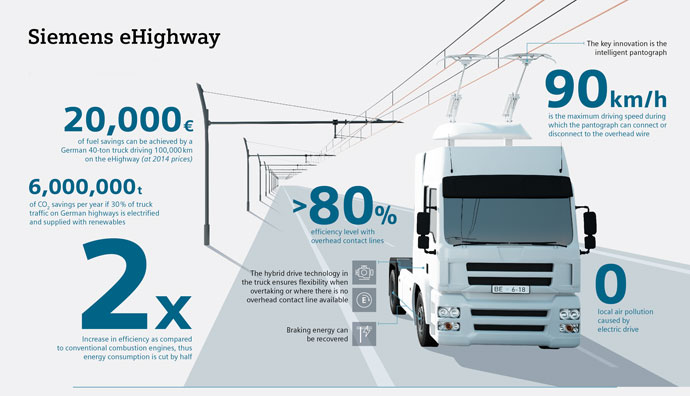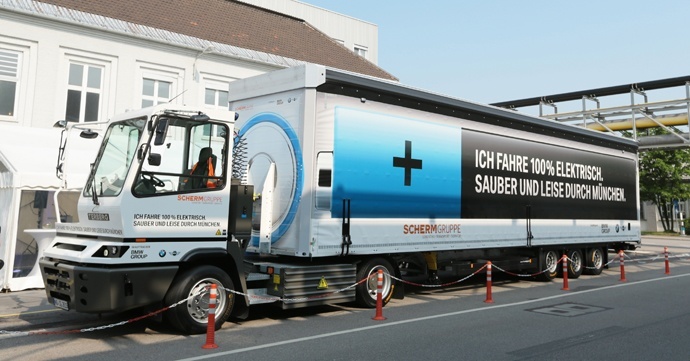
One day we may look back and wonder how 40-ton lorries were ever allowed to rumble through our villages and city streets. Though they make up only 3% of vehicles, lorries account for one quarter of Europe’s road transport emissions – a figure that’s expected to grow as traffic increases further. On top of that, heavy goods vehicles are involved in a disproportionate number of fatal crashes.
So lethargic is the response to persistent these threats, perhaps it should come as no surprise that the solutions proposed become ever more imaginative, if not practicable.
Small, but perfectly formed
They might be a fraction of the size of a lorry, but they can operate safely in pedestrian areas and create no local sound or air pollution. Delivery companies will later this month begin testing autonomous delivery robots on the pavements of London.

Smaller, quieter and safer than your average HGV
As part of the trial, dozens of robots will be deployed in five cities across Europe to run test deliveries and introduce the concept to the general public. The robots are designed to deliver parcels and food within in a 3-mile radius. The robots operate autonomously while being monitored by human operators in control centres. The robots have already driven 5,000 miles and encountered over 400,000 pedestrians without a single collision.
Is it an HGV or is it a tram?
Siemens has developed what looks like an HGV tram hybrid. The company claims its eHighway is twice as efficient as internal combustion engines. Rather than rely on a large diesel engine that can return as few as four miles per gallon, this hybrid approach delivers electricity via overhead power cables. The result is that energy consumption is halved and local air pollution lessened.

The first such system on a public road opened last month on a 2 km stretch of motorway north of Stockholm. As part of its climate protection strategy, Sweden has committed to having a fossil fuel independent transport sector by 2030.
Road safety going down the tubes
Year after year, heavy good vehicles (HGVs/lorries) are over represented in fatal collisions involving cyclists and pedestrians. In 2013, HGVs were involved in nine out of fourteen incidents in London leading to cyclist fatalities. Some have called for outright bans on HGVs from city streets during working hours. At the very least, we need road rules and attitudes that make cycling in our cities something for everyone – rather than only the brave.
Cambridge-based Mole Solutions has given development funds by the Department for the Environment, Food and Rural Affairs to explore the concept of using underground pipes to bypass congested roads.
Automated cargo trains would travel along one metre-wide pipes using magnetic fields for propulsion.
Speaking to The Independent, Roger Miles from Mole Solutions explained: “Clean water is taken into homes and dirty water is taken away and we never really see it, while huge amounts of oil and diesel are transported by pipes underground. Now we want to do something similar with freight, delivering goods to buildings and taking away waste”
“Congestion is a global issue and we could take a significant volume of traffic off the roads, not just in the UK but in countries like China and India. The bounds of this are limitless,” Mr Miles added.
BMW electric HGV

An entirely electric HGV used by BMW boasts all the benefits of battery power plus a cab with excellent driver visibility. The 40-ton electric truck now drives between the logistics company SCHERM and the BMW plant in Munich eight times a day. BMW is the first car maker in Germany to use an electric truck of this size to transport materials on public roads.
Thanks to its alternative drive train, the truck is quiet, emissions-free in traffic and generates virtually no particle pollution for the environment. The electric HGV produces 11.8 tons less CO2 per year than an equivalent diesel-powered lorry.
Can any HGV be safe for cyclists?
At the moment, the answer unfortunately is no. The best single piece of advice for cyclists in towns and cities is to be hyper aware of lorries at junctions and give them a wide berth whenever possible. It’s an example of the defensive riding that can help keep you safe, but why should the onus so often be on vulnerable road users?
Until we have the high quality infrastructure, road policing and legal framework to transform streets into places designed for people rather than motorised traffic, there must at the very least be mandatory safety equipment standards for the Heavy Goods Vehicles (HGVs) that operate on our roads to benefit cyclists and pedestrians. British law currently requires most HGVs to be fitted with side guards and extended view mirrors. However, certain HGVs, including construction vehicles are exempt from national regulations requiring side guards. Older HGVs are exempt from national regulations requiring mirrors.
“In more than 60 per cent of European cities, HGV movements are restricted”
Speaking to the Telegraph three years ago, Chris Boardman – a man who always talks sense about cycling – said: “I think their use in cities needs to be managed. In more than 60 per cent of European cities, HGV movements are restricted. In Paris, for example, there are no articulated vehicles in the centre of the city and there were zero cycling deaths last year. There is huge evidence in favour of it. These things are not happy bedfellows for cyclists. They should be restricted and it can be done. All those cities across Europe that have done it seem to be working fine. The Mayor told me he would look into it. I don’t know whether he has, but I certainly can’t see any action.”
0 Comments View now